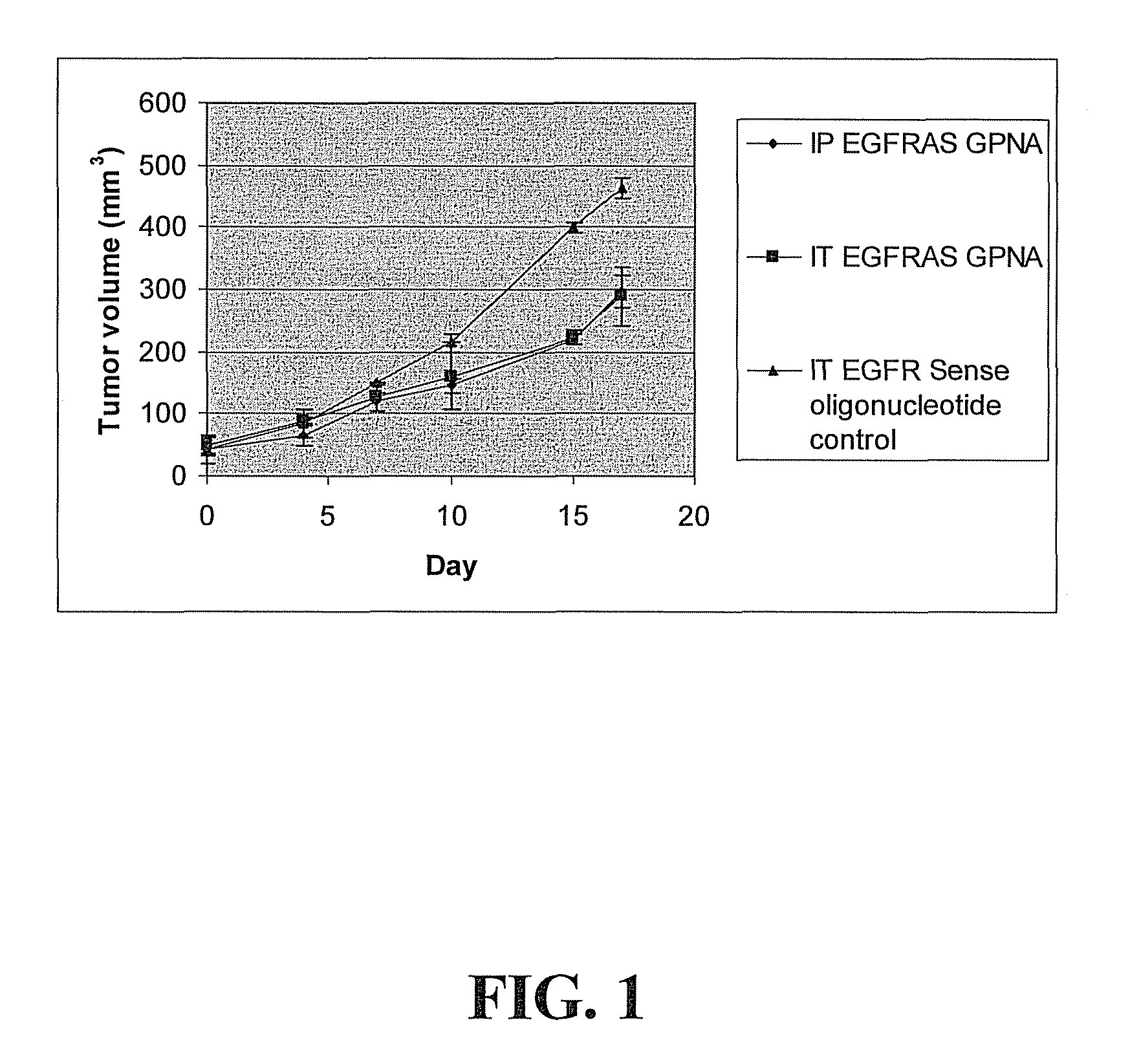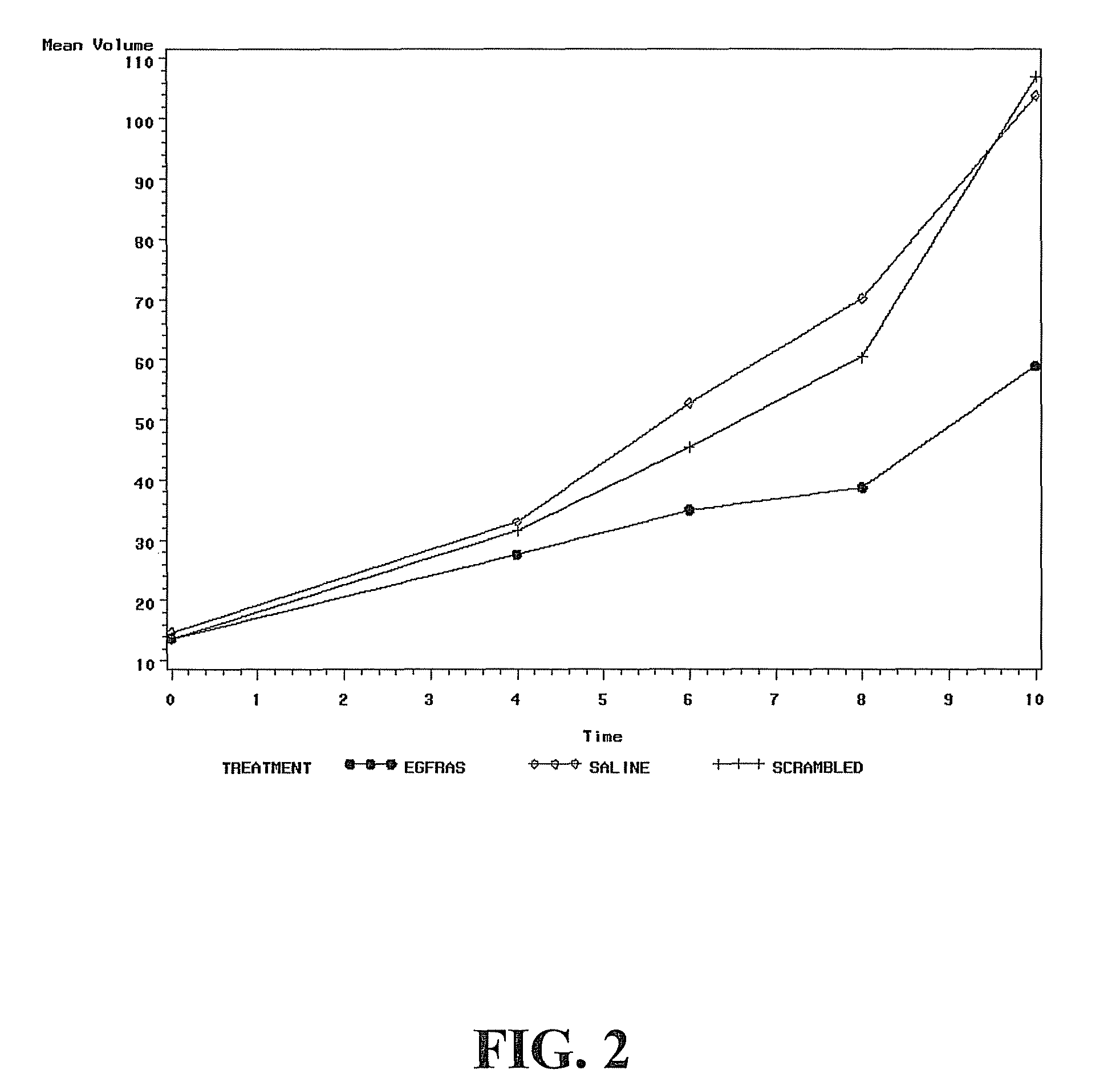Antisense guanidinium peptide nucleic acid (GPNA) oligonucleotides as antitumor agents
a guanidinium peptide and antitumor technology, applied in the field of gpna oligonucleotides, can solve the problems of increased egfr levels in hnscc tumors, large tumor size, and unfavorable treatment of hnscc patients, and achieve excellent uptake into mammalian cells and reduce the growth of hnscc tumors
- Summary
- Abstract
- Description
- Claims
- Application Information
AI Technical Summary
Benefits of technology
Problems solved by technology
Method used
Image
Examples
example 1
[0022]In vivo antitumor efficacy of EGFR antisense GPNA: As shown in FIG. 1, in order to examine the antitumor efficacy of EGFRAS GPNA (ARGCRAGRCTRCCRCARTTRGGRG (SEQ ID NO: 1)) in vivo a preliminary study was carried out in which athymic nude mice were inoculated with head and neck squamous cell carcinoma (HNSCC) cell line 1483 (106 cells per site). Tumors were allowed to establish for 10 days. The tumor volumes were measured using a vernier caliper. Mice were randomized into three groups such that the average of the tumor volumes in each group was the same. Two mice were treated with intraperitoneal (IP) injections of EGFRAS GPNA. Three mice were treated with intratumoral (IT) injections of EGFRAS GPNA and two mice were treated with EGFR sense oligonucleotide as a control. The mice were injected once per day for six days per week. Mice were administered 50 micrograms EGFRAS GPNA or EGFR sense oligonucleotide IT and 100 micrograms EGFRAS GPNA IP. Treatment was carried out for 16 day...
example 2
[0023]Systemic delivery of EGFRAS GPNA has specific antitumor effects in HNSCC xenografts: Referring now to FIG. 2, athymic nude mice were inoculated with HNSCC cell line 1483 subcutaneously with one million cells per flank. Animals were randomized into 3 groups based up on the tumor volumes. There were 11 mice in the EGFRAS GPNA group and 10 mice each in the saline and the EGFR scrambled groups. Saline or GPNA (5 mg / kg body weight) were administered via IP injections 5 days a week. Treatment was carried out for 10 days. Tumors were measured twice a week in 2 dimensions using a vernier caliper. Tumor volumes were estimated using the formula length×width (smaller dimension) / 2. There was a significant difference in the tumor volumes of mice treated with EGFR antisense GPNA compared to the scrambled GPNA (P<0.01). There was no significant difference between the tumor volumes of mice treated with the scrambled GPNA and saline.
PUM
| Property | Measurement | Unit |
|---|---|---|
| melting point | aaaaa | aaaaa |
| size | aaaaa | aaaaa |
| enzymatic stability | aaaaa | aaaaa |
Abstract
Description
Claims
Application Information
 Login to View More
Login to View More - R&D
- Intellectual Property
- Life Sciences
- Materials
- Tech Scout
- Unparalleled Data Quality
- Higher Quality Content
- 60% Fewer Hallucinations
Browse by: Latest US Patents, China's latest patents, Technical Efficacy Thesaurus, Application Domain, Technology Topic, Popular Technical Reports.
© 2025 PatSnap. All rights reserved.Legal|Privacy policy|Modern Slavery Act Transparency Statement|Sitemap|About US| Contact US: help@patsnap.com


